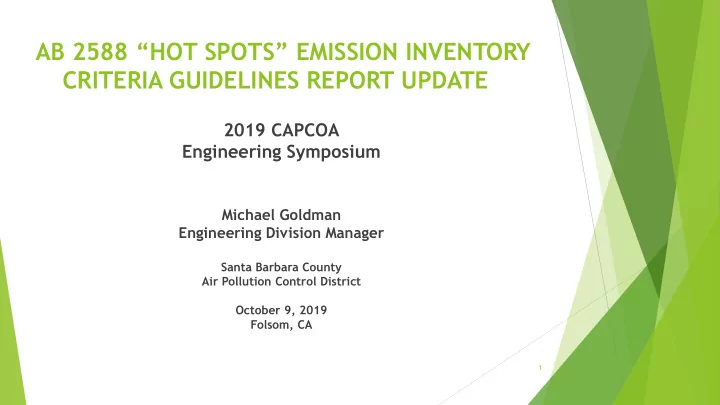

AB 2588 “HOT SPOTS” EMISSION INVENTORY CRITERIA GUIDELINES REPORT UPDATE 2019 CAPCOA Engineering Symposium Michael Goldman Engineering Division Manager Santa Barbara County Air Pollution Control District October 9, 2019 Folsom, CA 1
Presentation Overview What is the AB 2588 “Hots Spots” Program? Why are we revisiting the Program now? What’s been done so far? Who is subject to the Program? The Air Toxics Emissions Inventory Plan (ATEIP) The Air Toxics Emissions Inventory Report (ATEIR) CARB’s Proposed Updates to EICG Report (“Guidelines”) CAPCOA – Initial Concerns Help! Useful References EICG => Emission Inventory Criteria and Guidelines
What is the AB 2588 “Hots Spots” Program? Adopted in 1987 - Public right-to-know law Required detailed inventory of air toxics emissions, with prioritization, HRA, public notice (if necessary) Appendix A of Guidelines – Substances of Concern Routine and predictable operations of a facility Amended in 1992 (SB 1731) to require Risk Reduction A highly successful program 3
The Four Basic Steps Quantify - Air Toxics Emissions (500+ compounds) Assess - Offsite Impacts of Emissions Notify - Neighbors if Emissions Pose Significant Risk Reduce - Risk to Less-than-Significant Level 4
Ref: CARB. Anny Huang (2019) 5
Why Revisit the Program now? OEHHA updated Risk Assessment Guidelines 2015 Responds to SB 25 - Children’s Environmental Health Protection (1999) AERMOD Dispersion Model replaced ISC-ST3 Revision to the CAPCOA Prioritization Guidelines Updates to Consolidated Table of Health Values Diesel Engines Have not addressed facility-wide toxic impacts since mid-1990’s 6
What’s been done so far? OEHHA - The Air Toxics “Hot Spots” Program Guidance Manual for Preparation of Health Risk Assessments (March 2015) CARB - HARP 2 Update (2015) CARB/CAPCOA - Risk Management Guidelines (July 2015) CAPCOA Prioritization Protocol Update (August 2016) District Developed User Tools (e.g., screening tools, user guides) CAPCOA/CARB – IW Guidelines, Training, Emission Factor dBase 7
Who is subject to the Program? Facility emits > 10 tpy TOG, PM, NOx, SOx Applies to existing, new, and modified facilities that emit Appendix A Substances Appendix E – Facilities < 10 tpy TOG, PM, NOx, SOx “Industrywide” Facilities – District prepares the inventory, etc. Facilities identified as Posing Concern to Public Health (not in Appendix E) 8
The AB-2588 Air Toxics “Hot Spots” Emission Inventory Criteria and Guidelines Regulation The original Guidelines Report – Adopted April 1989 Amended numerous times. Last amendment in August 2007 H&SC § 93300.5. Incorporation by Reference. Requires subject facilities to comply with the Guidelines Amendments to the Guidelines require Board/OAL approval This is the Emission Inventory part of the AB 2588 process ATEIP – Air Toxics Emission Inventory Plan ATEIR – Air Toxics Emission Inventory Report Next Steps: Prioritization, HRA, Public Notification, RRAP 9
The ATEIP (Plan) ATIEP = Air Toxics Emission Inventory Plan Details Matter! GIGO (Garbage In -> Garbage Out) Defines the methods used to calculate the toxic emissions Detailed device, process, and stack data Includes all assumptions (e.g., load factors, control efficiencies, etc.) and documentation for those assumptions Detailed process flow diagrams and aerial photo map required Emissions Basis - details on the estimation methods, source test methods or other measurement methods that will be used to determine the toxic emissions Allows for Pooled Source Testing for groups of related facilities 10
The ATEIR (Report) ATEIR = Air Toxics Emissions Inventory Report Results of all sampling and source testing Facility diagram Emission calculations of facility air toxics data by device/process/stack Core Data Fields Form Information (Electronic data submittals accepted) Facility, Stack, Device, Process Emissions District-approved Alternative Submittal Formats are Allowed 11
CARB’s Proposed Updates - EICG Guidelines Appendix A – List of Substances. Possible addition of 400+ Substances Appendix C – Facility Guideline Index. Facility Lookup Table Appendix D – Source Testing. Requirements and alternatives Appendix E – Requirements for Smaller Facilities (< 10 tpy criteria pollutants) De Minimis Usage Thresholds. Usage or activity-based levels (e.g., gallons of fuel or solvent used). Examples: print shops, wastewater treatment plants, crematories, boat and ship building/repair, ethylene oxide sterilizers, diesel engines “Industrywide” Facilities Appendix F – Criteria for Screening HRAs 12
CARB’s Proposed Updates - Continued Appendix G – Updates to the Incorporated References (OEHHA Risk Guidelines, CAPCOA Prioritization) Section XI – Diesel Engine Reporting Requirements. Risk tables and modeling Other regulatory and technical updates to the main body of the Guidelines Timeline Started 2018 – Current focus is Appendix A Scientific Review Panel – Input on Appendix A changes – October 2019 Workshops expected in early 2020 CARB Board adoption expected November 2020 13
CAPCOA - Initial Concerns Workload Training Tools Diesel E/S Engines Gasoline Stations Coordination with AB 617 Criteria Reporting – Appendix A and Appendix E 14
HELP! Useful References AB 2588 - H&SC § 44300- § 44394: https://ww3.arb.ca.gov/ab2588/general.htm OEHHA - HRA Guidance Manual: https://oehha.ca.gov/air/air-toxics-hot-spots CARB – HARP 2: https://ww3.arb.ca.gov/toxics/harp/harp.htm CARB - Hot Spots Guidelines: https://ww3.arb.ca.gov/ab2588/2588guid.htm CARB/OEHHA – Health Values: https://ww3.arb.ca.gov/toxics/healthval/healthval.htm CAPCOA – Prioritization Guidelines: http://www.capcoa.org/ CARB/CAPCOA – Risk Mgmnt Guidelines: https://ww3.arb.ca.gov/toxics/rma/rma.htm CARB - Health Risk Assessments Training: Introductory and Intermediate Courses 15
Questions?
Recommend
More recommend